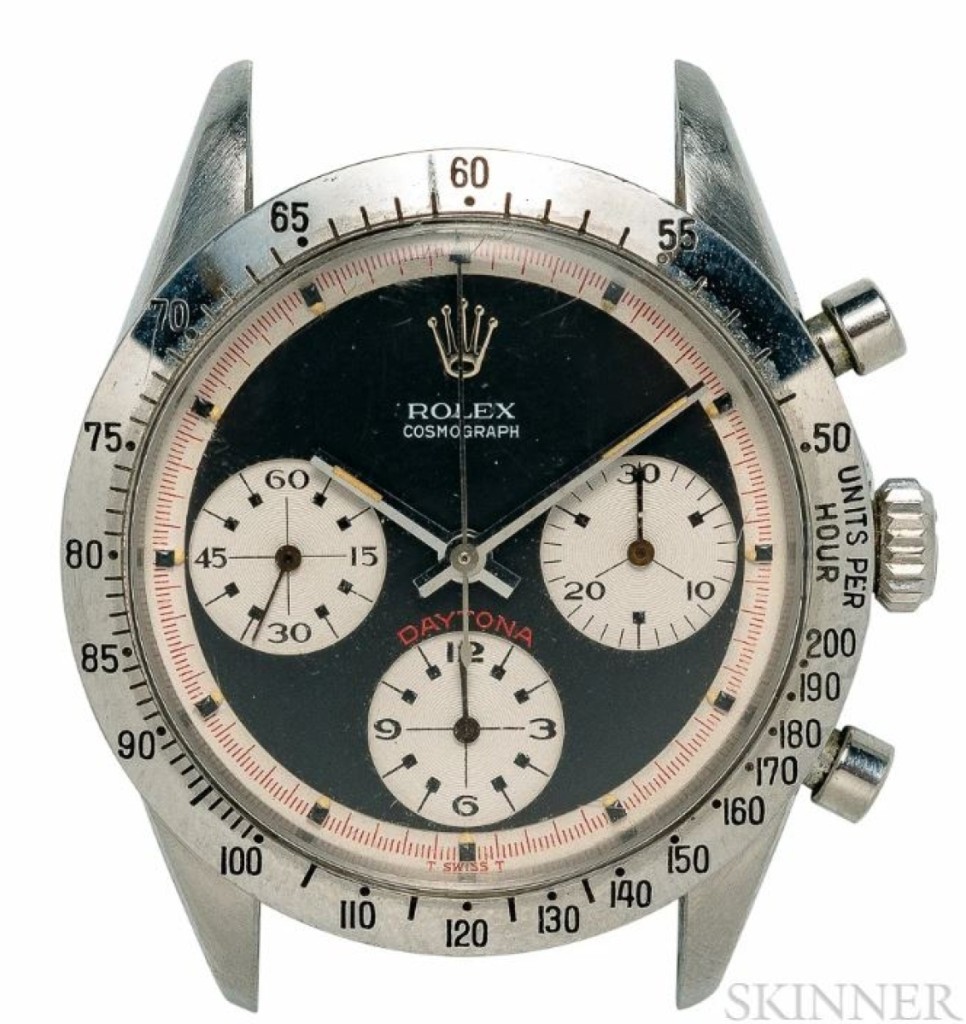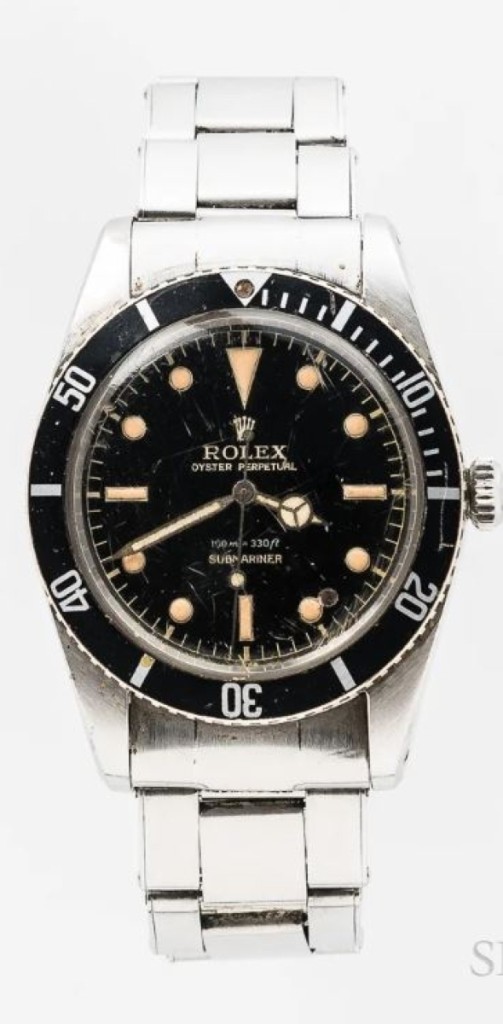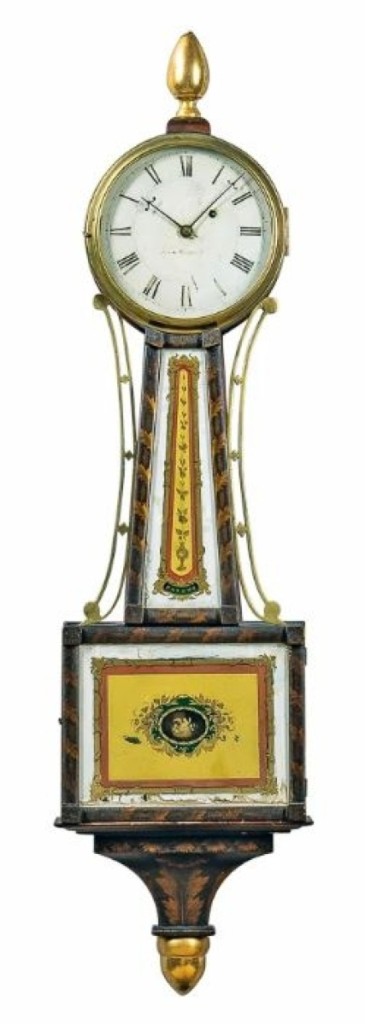
The sale’s top lot at $200,000 was a single-owner Rolex Daytona reference 6239 “Exotic” dial wristwatch. The owner had purchased it for $235 in the early 1970s. Sale director Jonathan Dowling said the piece was in immaculate condition, never serviced or opened since its manufacture, and he would likely never see another in this condition for the rest of his career.
Review by Greg Smith, Catalog Photos Courtesy Skinner Inc.
MARLBOROUGH, MASS. – For some, the outbreak and isolation makes time stand still, but for others, like Skinner Inc., it picks up pace as was clear for the firm’s Clocks, Watches & Scientific Instruments Online sale April 6-14, which brought in $1,085,488 on 395 lots. The sale went 94 percent sold and had a 40 percent increase in bidder participants over the department’s last sale.
The sale caught worldwide interest according to Jonathan Dowling, director of Skinner’s clocks, watches and scientific instruments department.
“Watches are the fastest growing area within the department,” Dowling told Antiques and The Arts Weekly. “I personally take a lot of interest in wristwatches, I’ve been involved in collecting them for the last six or seven years while building this department. Focusing on wristwatches has been a pleasure. We used to sell them through the jewelry sale and discovery sale but now we are focusing on offering them through more dedicated sales.”
Dowling’s focus paid off when a single-owner Rolex Daytona reference 6239 “Exotic” dial wristwatch sold for $200,000 above a $120,000 high estimate. It sold to an American collector.
The watch is circa 1968 with an engraved tachymeter bezel, black tricolor dial, full concentric turned subsidiary dials, creamy lume plots, signed screw-down crown, pump pushers, manual-wind caliber 722 movement, screw-back case, with a later oyster riveted bracelet.
Get ready for it: the buyer bought the watch for $235. It came with its original receipt.

Twelve lots in the sale had provenance to the Norfolk Southern Railway. Among them was an E. Howard & Co. No. 22 mahogany astronomical regulator that brought $106,250 on a $60,000 high estimate. Model 22s are extremely rare.
Skinner wrote, “The consignor recalls purchasing this watch in 1970 or 1971…In 1967, he traded a 1963 Triumph TR4 for a 1962 two-door Cadillac Eldorado convertible, and being financially secure at the time, he was in the market for a chronograph…This example is in a rare state of preservation with the untouched dial that has aged softly with its complete lume plots intact, and an undisturbed movement. It was opened by Skinner for the first time since its manufacture date.”
On what made the example so desirable, Dowling said, “Condition, condition, condition. This was absolutely pristine. I don’t think I’ll ever see another one in my career in such wonderful condition.”
Behind at $106,250 was an E. Howard & Co. No. 22 mahogany astronomical regulator with provenance to the Norfolk Southern Railway.
“There were not many No. 22s made,” Dowling said. “I heard from a collector within the last few weeks that one was offered a few years back at an auction and prior to that it was decades. We had never seen one. Robert Cheney [Skinner’s previous department director], my teacher, never saw one in his career. It was a rare piece. This was a larger model, there’s another model with the same case in a smaller size.”

The second highest selling wristwatch in the sale was this single-owner unserviced Rolex reference 5508 “James Bond” wristwatch from 1958, which sold for $53,125.
Eleven other clocks in the sale had provenance to the Norfolk Southern Railway, including five total E. Howard & Co regulators. Another good result for the company was found in an E. Howard & Co. No. 25 astronomical floor regulator, which doubled estimate to bring $45,750. At $20,000 was an E. Howard & Co. walnut jeweler’s wall regulator.
Selling for $100,000 was the Clement Clock, a monumental carved English oak quarter-chiming, musical, triple calendar hall clock, from late Nineteenth Century London. The case featured profuse and deep carving with figures, busts, cupids and floral ornamentation. The dial reads “Alfd Marsh at ye Dial Opposite ye Bank of England London.”
The Clement Clock was sold to benefit the Vermont Historical Society.
Skinner wrote, “The Clement Clock records comprise documentation removed from the museum collection files of the Vermont Historical Society relating to the large, ornate, English “great-grandfather” clock that was purchased circa 1914 by Percival Clement of Rutland, placed in the State House in 1920, and made an outright gift to the Vermont Historical Society in 1944.
“Prior to its coming to Vermont, the clock adorned the interior of the Grosvenor Hotel in Chester, England. Percival W. Clement (1846-1927; Governor of Vermont, 1919-1920) admired the clock and made arrangements to purchase it in 1914, originally intending to place it in the Hotel Woodstock in New York City, of which he was then owner. Transport to the United States was delayed because of World War I, and by the time it could be shipped in 1920, Clement no longer was owner of the Hotel Woodstock, but as he was then serving as governor of Vermont, the clock was installed in the governor’s chambers. It was subsequently moved to the Reception Room in the State House, where it remained on loan until 1944, when Mr Clement’s heirs formally donated it to the Vermont Historical Society.”

According to the consignor, a previous owner of this Simon Willard banjo clock, Charles Livingstone, was invited on a fishing trip where over dinner his friend told him he had discovered it for sale in Bangor, Maine. Livingstone then left the table, drove to Bangor, found the clock, bought it, and was never invited fishing again. It sold for $33,750.
Another recounting of note is found in the provenance line of a circa 1825 Simon Willard & Co. stenciled-front patent timepiece, or “banjo” clock, that brought $33,750 over a $12,000 estimate. Skinner wrote, “According to the consignor, the clock was acquired by Charles Snow Livingstone, known to his friends as ‘Chick.’ He and his wife, whose maiden name was Hildegarde Brandegee, a concert pianist, were avid antique collectors. Chick grew up in the coastal town of Calais, Maine, the son of a ship’s blacksmith and dry dock owner. One year prior to WWII, he was invited by friends on a fishing trip to New Brunswick, Canada. At dinner one evening one of the friends announced he had discovered a Simon Willard for sale in Bangor, Maine. Chick excused himself from the table, went directly to his car and drove to Bangor. He found and purchased the clock, beating his friend to it. He was never invited to go fishing again. The clock was in his house at 8 Brook Street, in Winchester, Mass., until his death; it then went to Lancaster, N.H. In 1977 it moved to the Stone House, on the St Croix River in Calais, Maine, where it hung on the wall, running, until 2017.”
Other wristwatches in the sale did exceptionally well. At $53,125 was a single-owner unserviced Rolex reference 5508 “James Bond” wristwatch, from 1958, with a glossy black dial with gilt printing and pumpkin-colored indices, Mercedes hand set, original signed “small” crown, unpolished case, and a 25-jewel caliber 1530 automatic movement with original “butterfly” rotor. Skinner noted the 5508 was the last Submariner to carry the “100=300ft” rating. At $36,250 was a Tornek-Rayville TR-900 sterile dial dive watch, circa 1964. The stainless steel water-resistant antimagnetic dive watch has a sweep center second hand made for the US Navy. For something more glitzy, bidders turned to a Patek Philippe signed Tiffany & Co. reference 2457 wristwatch in 18K gold, which took $16,250.
Dowling said he had a very busy run-up to the sale with inquiries. “These collectors have specific questions, some I wouldn’t have even thought to ask, but we were able to walk them through and bidding was strong as a result.”
All prices reported include buyer’s premium, as stated by the auction house. For information, www.skinnerinc.com or 617-350-5400.













